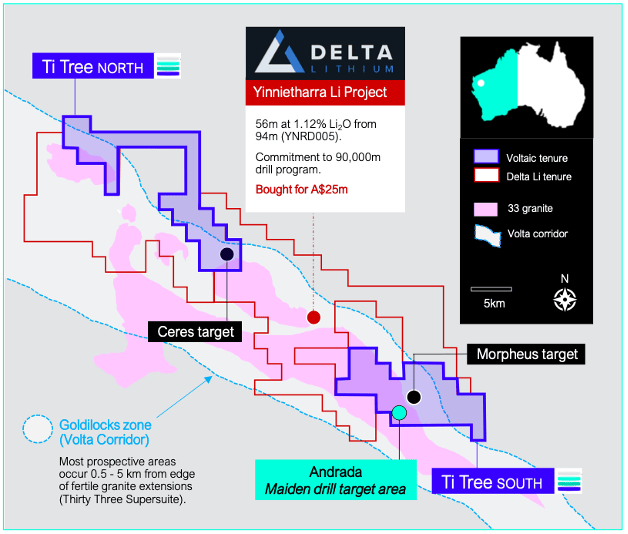Voltaic on the hunt for more pegmatites in phase 2 drilling at WA lithium project
Mining
Mining
Voltaic Strategic Resources has commenced a 3,000m phase 2 drilling campaign at its Ti Tree lithium project in WA, after drilling intercepted up to 58m of continuous pegmatites from surface last month.
The primary aim is to define the extents and along-strike continuity of Andrada’s wide pegmatites, and to test six additional first-pass targets at Andrada and the nearby Morpheus prospect.
Notably, both targets are located within the Volta Corridor – a major belt of lithium-bearing pegmatites hosting Delta Lithium’s (ASX:DLI) Yinnetharra Lithium Project where a 90,000m drill program is underway.
This phase 2 drilling program has been expedited by phase 1 success – along with a recent placement which raised $7.1 million and was strongly supported by existing and new shareholders.
Voltaic Strategic Resources (ASX:VSR) CEO Michael Walshe said phase 1 drilling “barely scratched the surface in terms of understanding the depth and scale potential of our tenure.”
“Our initial rock chip sampling campaigns identified >300 pegmatites across our ‘Volta Corridor’ and confirmed that several of them are geochemically ‘fertile’ for LCT mineralisation,” he said.
“Phase 1 drilling confirmed that many of these pegmatites have significant size potential, and we still have not identified their structural bounds.
“Following the extremely strong level of support for the $7m placement, we are now well funded to realise our ambitious plans to vector to the best part of our tenure at Ti Tree.”

Deeper drilling into fresher/less oxidised pegmatite zones should identify bounding lithological contacts at depth, and provide enhanced geochemical vectoring insights down-dip.
Voltaic’s drilling to date has only tested the top ~29m vertical depth from surface and several of the large pegmatites identified remain open at depth and without any bounding lithological contacts.
The company expects that deeper drilling into fresher/less oxidised zones should assist with identifying lithological contacts, and provide enhanced geochemical vectoring data down-dip.
And when combined with the pending assay data from phase 1, this campaign will provide valuable structural and lithological data to guide subsequent deeper drilling into the most prospective modelled parts of the LCT system at the project.
“Additionally, target generation continues to generate LCT targets along the most prospective lithological schists associated with the ‘Volta Corridor’, with rock chip sampling, geological mapping, and soil sampling programs all underway across Ti Tree (South), and several geophysical surveys are planned to commence in June,” Walshe said.
This article was developed in collaboration with Voltaic Strategic Resources, a Stockhead advertiser at the time of publishing.
This article does not constitute financial product advice. You should consider obtaining independent advice before making any financial decisions.